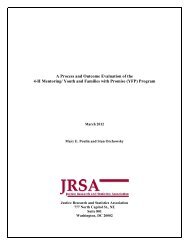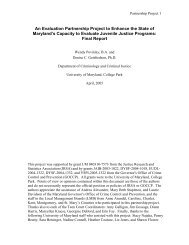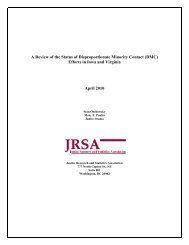Juvenile Justice System and Risk Factor Data - Illinois Criminal ...
Juvenile Justice System and Risk Factor Data - Illinois Criminal ...
Juvenile Justice System and Risk Factor Data - Illinois Criminal ...
Create successful ePaper yourself
Turn your PDF publications into a flip-book with our unique Google optimized e-Paper software.
Community risk factors<br />
Community risk factors are related to the broader social environment in which minors reside.<br />
Studies examining the impact of environmental factors on juvenile delinquency have found<br />
evidence that communities with high levels of poverty or that are socially disorganized also tend<br />
to have high levels of juvenile delinquency. Research also has revealed that juvenile delinquency<br />
is correlated with drug availability, high levels of adult criminality, exposure to violence, <strong>and</strong><br />
exposure to racial prejudice in the community. 7<br />
Social risk factors<br />
Social risk factors are circumstances that are present in a minor’s immediate environment <strong>and</strong><br />
typically include family relationships <strong>and</strong> peer relationships. Strong evidence suggests weak<br />
parent-child relationships including poor parental discipline style <strong>and</strong> lack of parental<br />
involvement, as well as relationships with antisocial or delinquent peers, are related to juvenile<br />
delinquency.<br />
Researchers Lipsey <strong>and</strong> Derzon (1998) reported results of a statistical review of longitudinal<br />
research examining juvenile delinquency risk factors. 8 They found that certain family-related risk<br />
factors, such as antisocial parents <strong>and</strong> parent criminality, were more predictive of serious <strong>and</strong><br />
violent juvenile delinquency for six to 11 year olds than for 12 to 14 year olds. Peer-related risk<br />
factors including antisocial peers or peer criminality were more predictive of serious <strong>and</strong> violent<br />
juvenile delinquency among 12 to 14 year olds.<br />
Family <strong>and</strong>/or marital conflict, separation from family, <strong>and</strong> sibling delinquency also are proven<br />
risk factors for juvenile delinquency. In addition, abusive parents, low family bonding, high<br />
family stress, weak social ties including unpopularity with peers <strong>and</strong> low levels of social activity,<br />
<strong>and</strong> high family residential mobility may be linked to juvenile delinquency. 9 Additional research<br />
to further explore <strong>and</strong> support these findings is needed before conclusions regarding these<br />
potential risk factors can be made.<br />
School risk factors<br />
Research on predictors of serious <strong>and</strong> violent juvenile delinquency has revealed that truancy,<br />
dropping out of school, <strong>and</strong> poor academic performance are related to juvenile delinquency. In a<br />
meta-analysis of risk factors for delinquency, Hawkins et al (1998) found that academic failure<br />
<strong>and</strong> low school attachment were significant predictors of juvenile delinquency. 10 11

















